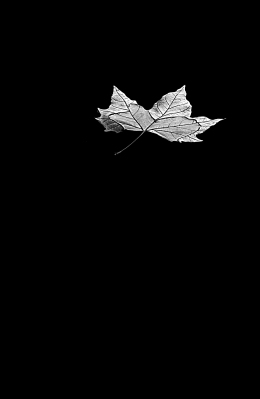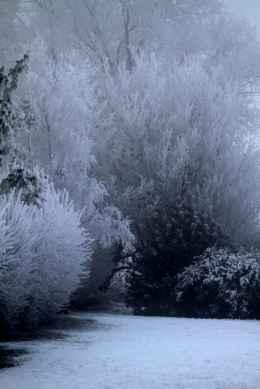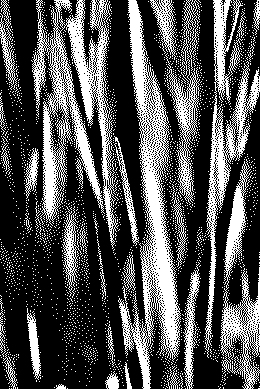The girl always sat on the old stone wall in the cool of the sprinkling stream under the rustling shade tree. Even when the other children played between lessons in the old schoolhouse, the little girl walked straight to where the young grey cat was waiting to curl up in her lap. She sat by herself and contemplated the world, which revealed its strangeness to her, day by day, washed by the scent of the lime trees and surrounded by bees and butterflies. On this day a heavy summer shower had fallen and all of the children had shared her shelter. She didn't mind and even spoke a little, quiet and shy, while the boys teased and pulled her pale hair and the other girls tried to guess the name of her kitten.
The rain stopped, but not before the sun had broken out from behind the dark clouds. Of course, the rainbow came with its palette of brilliant colours and the moment which the little girl had dreaded arrived. From the houses the elders streamed running to the school. A few had small baskets, others long hooked poles. 'Children children' they cried pointing to the rainbow and the other children started to dance joyously in the wet, scented earth. The elders picked a dozen children. Children who had to be just tall enough, but have fingers just small enough and most important of all, whose fingers must be clean and their nails impeccably cut. The little girl reached down to dirty her hands, but the village blacksmith caught her wrist with good humour, thrusting a basket in one hand and a hooked pole in the other.
Already, the rest of the children were running toward the rainbow. Beneath it, they jumped and caught the underside with their pole, pulling it down until they could take the colours in their hands and peel its scales into their basket. All of this they had to do without bruising the rainbow or frightening it away. Glumly the little girl reached her allotted space and reached up with her stick. The stick, of course, passed right through. Already, the rest of the childrens' baskets were filling with colour. The little girl tried again, and a third time but it was no good.
One of the older children, who had harvested the rainbow before, moved to stretch it for her to touch. While the older child captured a handful of violet scales and let them flutter into her basket, the little girl reached out and folded her fingers around the rainbow. She felt nothing. Perhaps the faintest silky touch, perhaps a slight coolness, but the rainbow passed right though her fingers. She slumped down on the ground but didn't cry and a moment later an elder led her away without a word. When she turned to look back, her replacement was gleefully putting petals of buttery yellow into the basket.
Time passed and the little girl was overlooked whenever the rainbow came. By the next spring, when there was enough sun for the rainbow to come, she was too tall and kept her nails too long to be a rainbow harvester and no one said another word.
Another year later, and the little girl's mother stroked back her hair one morning, looked into her amber eyes and pronounced her pale. She took her to the village herbalist, who declared no substantial illness and sent them both away. The girl sat under the tree, each day, and watched the world and the world, it seemed, paid her very little attention at all until midsummer. That day, when the whole village was dancing and finely dressed, eating rainbow cakes and drinking rainbow wine, she noticed that her hands were paler still. The palms of her hands were almost white. The tutting herbalist, gave her a bottle of pills. Rainbow Pills, she said, for her colour.
The girl took the pills all through the autumn and winter when, if the truth were told, the whole village was a bit grey, and most people took a rainbow pill to ward off the gloom. The farmers spread finely ground rainbow-green on their fields. When the spring returned, so did the colour to their cheeks, but not to the girl. On the first day of bright sun, before the leaves had even opened, the village was already talking of the girl who had almost turned thin and almost grey over the winter. The herbalist and the doctor came to her, again, conferred grimly, and prescribed the purest essence of rainbow for the girl. She drank the potion but the colours simply drained out of her feet wherever she walked, where they were soon lapped up by the cat.
The girl became weaker as that summer progressed, and was soon confined to her bed. She could hear the children playing when the wind played with the curtains. She tried rainbow baths and swaddling in rainbow sheets, but nothing worked. Finally, they called for the priest who came and held the girl's hand beside the bed. He asked her what the matter was and she replied, almost invisible now, that she couldn't believe in the rainbow. The priest asked if she believed the evidence of her senses. Could she not smell her beloved lime tree, or hear the waterfall? Did she not believe in her cat, which she was stroking idly, its fur a luscious gold now, and its eyes as bright and sharp as emeralds? Could she not also see the rainbow when it came? She answered by asking the priest when he had last dared touch the rainbow, and he could not answer.
A few days later, the girl had almost disappeared and no one noticed her anymore. She hardly felt real at all. With a last effort, she left the house in a thunderstorm to go and stand one last time by the stream. When the rain ended, of course, the rainbow returned and with it this year's children to harvest its scales. The villagers couldn't see her, because she was too strange. As invisible as a pool of water she walked under the rainbow and with her last strength, she reached up and touched the silky light. But it was still too distant and too late.
And so the wind picked her up instead, because the wind had always brought her presents, like the scents the great lime tree and the voices of the villagers, and the wind had always believed in her, though it never occurred to her that she should believe in it, and it carried her away. The villagers shook their heads for a moment, as though something were missing, and her mother paused briefly when next she sprinkled the rainbow spices into the casserole pot, but only the cat missed her.



 Velvet Snoutingdingle
Velvet Snoutingdingle